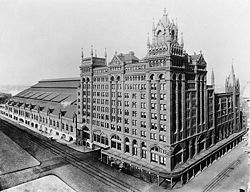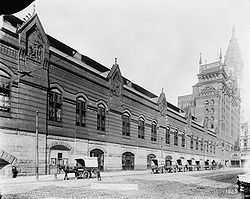
Penn Center, Philadelphia, Pennsylvania
Encyclopedia

Central business district
A central business district is the commercial and often geographic heart of a city. In North America this part of a city is commonly referred to as "downtown" or "city center"...
. It derives its name from the nearly five million square foot office and retail complex that helped transform it from a gritty industrial and low-rent commercial district into the centerpiece of Philadelphia's business district in the late 20th century. It is located between 15th and 19th Streets, east to west and from John F. Kennedy Boulevard to Market Street
Market Street (Philadelphia)
Market Street, originally known as High Street, is a major east–west street in Philadelphia, Pennsylvania. For the majority of its length, it serves as Pennsylvania Route 3....
, north to south. It is credited with bringing Philadelphia into the era of modern office buildings.
The Chinese Wall


Pennsylvania Railroad
The Pennsylvania Railroad was an American Class I railroad, founded in 1846. Commonly referred to as the "Pennsy", the PRR was headquartered in Philadelphia, Pennsylvania....
brought passenger service into the center of the city, and constructed the first Broad Street Station
Broad Street Station (Philadelphia)
Broad Street Station at Broad & Market Streets was the primary passenger terminal for the Pennsylvania Railroad in Philadelphia, Pennsylvania from 1881 to the 1950s...
just west of City Hall
Philadelphia City Hall
Philadelphia City Hall is the house of government for the city of Philadelphia, Pennsylvania. At , including the statue, it is the world's second-tallest masonry building, only shorter than Mole Antonelliana in Turin...
. The sea of iron pillars holding up the PRR's elevated trackbed was replaced in the 1890s by a 10-block stone viaduct
Viaduct
A viaduct is a bridge composed of several small spans. The term viaduct is derived from the Latin via for road and ducere to lead something. However, the Ancient Romans did not use that term per se; it is a modern derivation from an analogy with aqueduct. Like the Roman aqueducts, many early...
to the Schuylkill River
Schuylkill River
The Schuylkill River is a river in Pennsylvania. It is a designated Pennsylvania Scenic River.The river is about long. Its watershed of about lies entirely within the state of Pennsylvania. The source of its eastern branch is in the Appalachian Mountains at Tuscarora Springs, near Tamaqua in...
. This created a block-wide barrier known as The Chinese Wall, cutting the western portion of the city in half and discouraging development there.
At the time, most commercial activity in Center City was east of Broad Street
Broad Street (Philadelphia)
Broad Street is a major arterial street in Philadelphia, Pennsylvania, and is nearly 13 miles long.It is Pennsylvania Route 611 along its entire length with the exception of its northernmost part between Old York Road and Pennsylvania Route 309 and the southernmost part south of Interstate 95...
, which is why the SEPTA Market-Frankford Line
Market-Frankford Line
The Market–Frankford Line is a rapid transit line in Philadelphia, Pennsylvania, United States, operated by the Southeastern Pennsylvania Transportation Authority .-Route:The Market–Frankford Line begins at 69th Street Transportation Center, in Upper Darby...
has no stops between 30th Street Station
30th Street Station
30th Street Station is the main railroad station in Philadelphia, Pennsylvania, and one of the five stations in SEPTA's Center City fare zone. It is also a major stop on Amtrak's Northeast and Keystone Corridors...
and 15th Street
15th Street (SEPTA station)
15th Street is a rapid transit station on the SEPTA Market–Frankford Line and all routes of the Subway–Surface trolley lines in Philadelphia, Pennsylvania. A free interchange is available between all of the rapid transit lines here, including the Broad Street Line at City Hall, which is connected...
. (The stations at 19th Street and 22nd Street are served by SEPTA Subway-Surface Trolley Lines
SEPTA Subway-Surface Trolley Lines
The Subway–Surface Trolley Lines or Green Lines are five SEPTA trolley lines that operate on street-level tracks in West Philadelphia and Delaware County, Pennsylvania, and in a shared subway with rapid transit trains in Philadelphia's Center City....
.)
Urban renewal
In 1925, the Pennsylvania Railroad announced its intention to leave Broad Street Station, freeing the land for redevelopment. The railroad, which had outgrown the station, would move its operations to the newly constructed 30th Street Station30th Street Station
30th Street Station is the main railroad station in Philadelphia, Pennsylvania, and one of the five stations in SEPTA's Center City fare zone. It is also a major stop on Amtrak's Northeast and Keystone Corridors...
and Suburban Station. Broad Street Station was not completely vacated until 1952, during the term of Mayor Joseph S. Clark
Joseph S. Clark
Joseph Sill Clark, Jr. was a U.S. lawyer and Democratic Party politician in the mid-20th century. He served as the mayor of Philadelphia from 1952 until 1956, and as a United States Senator from Pennsylvania from 1957 until 1969...
. Plans for the demolition of The Chinese Wall and accompanying train station were finalized and both were razed in 1953.
Ed Bacon, the executive director of the City Planning commission, came up with a master plan for a four block area to be cleared. Bacon named the new site Penn Center with the hopes that it would become a business center and model for future development. His plan for the redevelopment of the site included three large office towers, a pedestrian mall, and an underground concourse where retail and business was to be located. The Pennsylvania Railroad wanted to sell the land off in smaller lots for piecemeal development, but Mayor Clark used his political clout to see that Bacon's plan was realized. The plan was implemented with public support, but it would come into criticism later from urban planners, including Jane Jacobs
Jane Jacobs
Jane Jacobs, was an American-Canadian writer and activist with primary interest in communities and urban planning and decay. She is best known for The Death and Life of Great American Cities , a powerful critique of the urban renewal policies of the 1950s in the United States...
for placing vibrant urban activity underground leaving no use for the above ground promenade, and failing to account for actual human usage of the space.
Current
Throughout the mid- to late 20th century, the city's office sector began to move west into the Penn Center area, thanks to planning efforts. As the office-working population became more suburbSuburb
The word suburb mostly refers to a residential area, either existing as part of a city or as a separate residential community within commuting distance of a city . Some suburbs have a degree of administrative autonomy, and most have lower population density than inner city neighborhoods...
anized, convenient access to Suburban Station
Suburban Station (Philadelphia)
Suburban Station is an underground, art deco, commuter rail station in the Penn Center district of Center City Philadelphia, Pennsylvania. Its official SEPTA address is 16th Street and JFK Boulevard. The station is operated by SEPTA and is one of the three core Center City stations on the SEPTA...
began to take precedence to city planners over local city transit access.
Today, the Penn Center name is officially attached to 11 mid- and highrise office buildings.
Most of the buildings of the complex are connected to the Suburban Station retail concourse (renovated in 2007) and by extension the Center City Concourse. The buildings share a loading and delivery entrance on Commerce Street which connects to all the buildings underground. Although not part of Penn Center, Comcast Center
Comcast Center (office building)
Comcast Center is a skyscraper in Center City, Philadelphia, Pennsylvania. The 58-story, tower is the tallest building in Philadelphia and the fifteenth tallest building in the United States. Originally called One Pennsylvania Plaza when the building was first announced in 2001, the Comcast Center...
connects to the concourse and the option is being examined for the proposed American Commerce Center
American Commerce Center
The American Commerce Center was a supertall skyscraper approved for construction in Philadelphia, Pennsylvania. At tall with 63 floors, the building would dominate the Philadelphia skyline, standing over taller than Philadelphia's current tallest building, the recently completed Comcast Center...
.
The Buildings
| Name | Height Feet (meters) |
Floors | Year | Notes |
|---|---|---|---|---|
| One Penn Center (Suburban Station) | 330 feet (101 m) | 20 floors | 1929 | Originally Pennsylvania Railroad Suburban Station. The numbers of the Penn Center buildings generally radiate clockwise around the building. |
| Two Penn Center | 271 feet (83 m) | 20 floors | 1958 | |
| Three Penn Center (1515 Market Street) | 270 feet (82 m) | 20 floors | 1953 | Currently known as 1515 Market Street, this was the first of the modern Penn Center buildings. |
| Four Penn Center | 275 feet (89 m) | 20 floors | 1964 | Completely renovated in 2001. |
| Five Penn Center (1601 Market Street) Five Penn Center Five Penn Center is a 36-story highrise in downtown Philadelphia, Pennsylvania. It is part of the Penn Center complex designed by Edmund Bacon. The building was one of the tallest in the city until the highrise building boom of the late 1980s and early 1990s and is connected via underground... |
490 feet (149 m) | 36 floors | 1970 | Tallest Penn Center building before the completion of the Mellon Bank Center Mellon Bank Center BNY Mellon Center is a 54-story skyscraper located in Philadelphia, Pennsylvania. The height to its structural top is 792 ft . Construction was completed in 1990... . |
| Six Penn Center | 18 floors | 1988 | Now known as The Morgan, Lewis & Bockius Building. | |
| Seven Penn Center | 269 feet (82m) | 21 floors | ||
| Eight Penn Center | 284 feet (87 m) | 23 floors | 1982 | Site was originally an ice skating rink. |
| Nine Penn Center (Mellon Bank Center) Mellon Bank Center BNY Mellon Center is a 54-story skyscraper located in Philadelphia, Pennsylvania. The height to its structural top is 792 ft . Construction was completed in 1990... |
792 feet (241 m) | 54 floors | 1990 | Site was originally Greyhound Bus Terminal. |
| Ten Penn Center | 306 feet (93 m) | 28 floors | 1980 | Lobby completely renovated in 2000. |
| Eleven Penn Center (1835 Market Street) 1835 Market Street 1835 Market Street, formerly known as Eleven Penn Center, is a high-rise building located in the Market West region of Philadelphia, Pennsylvania. The building stands at 425 feet with 29 floors, and was completed in 1986. It is currently the 21st-tallest building in Philadelphia. The architectural... |
425 feet (130 m) | 29 floors | 1986 | An unusual hexagonally shaped building with mansard roof. |
| Sheraton Penn Center Hotel | 27 floors | 1957 | Demolished; former site of the Public Defender Building and current site of Comcast Center Comcast Center (office building) Comcast Center is a skyscraper in Center City, Philadelphia, Pennsylvania. The 58-story, tower is the tallest building in Philadelphia and the fifteenth tallest building in the United States. Originally called One Pennsylvania Plaza when the building was first announced in 2001, the Comcast Center... . |
|
| Penn Center Inn | 22 floors | Demolished in 1990 to make way for the second IBX Tower G. Fred DiBona Jr. Building The G. Fred DiBona Jr. Building, formerly known as the Blue Cross-Blue Shield Tower or IBX Tower, is a skyscraper in Philadelphia, Pennsylvania housing the headquarters of Independence Blue Cross... , which was never built. Site remains undeveloped. |
External links
- 'Developmentally Disabled' a Philadelphia Weekly article that discusses the history of planning in Philadelphia and specifically addresses Penn Center
- 'The History of LOVE Park' a history of LOVE park that discusses Penn Center
- 'Urban Renewal in Philadelphia' a history of the development of Penn Center containing many historical photographs

